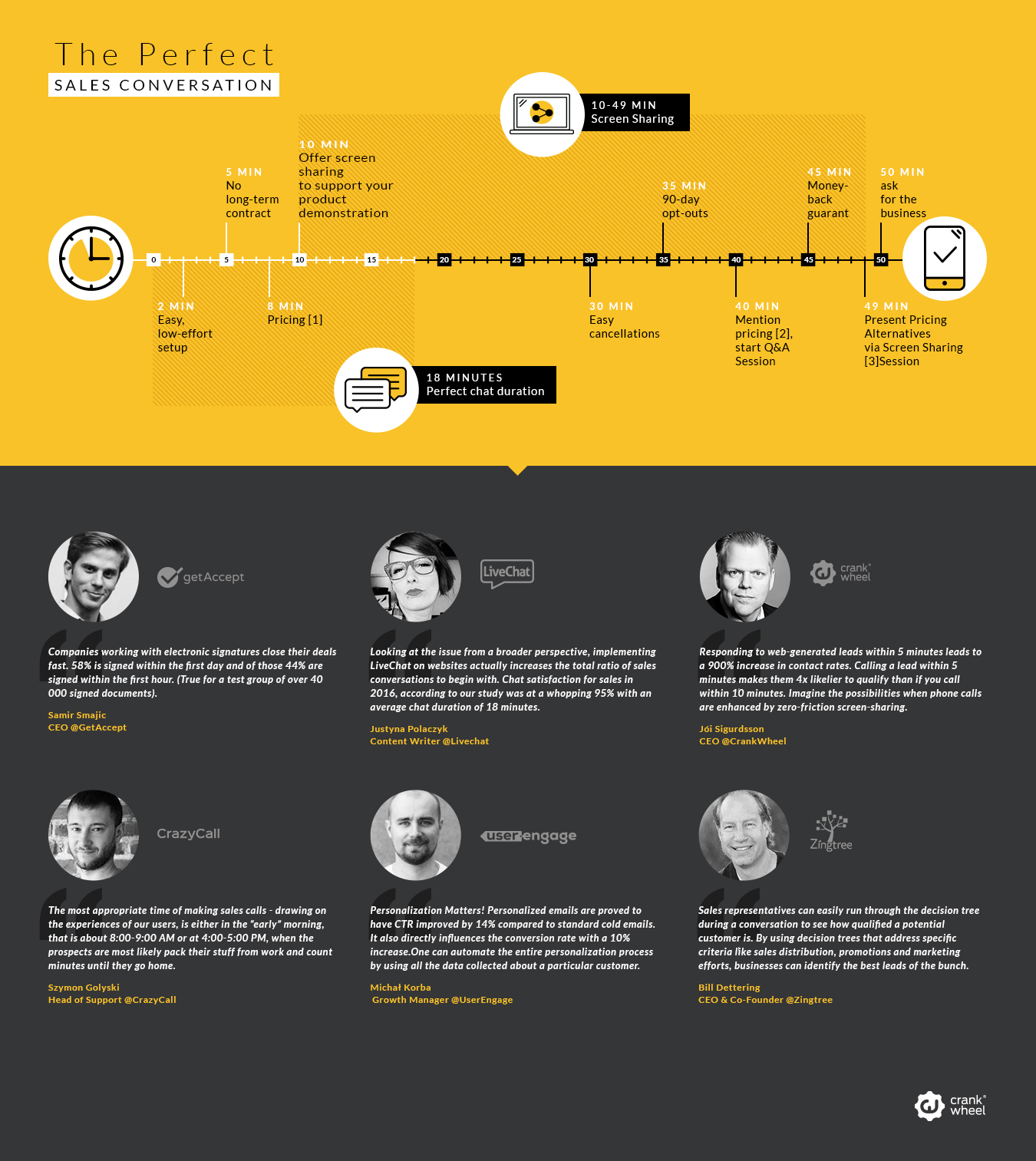The Perfect Sales Conversation
You all know that at CrankWheel, we are absolutely insane when it comes to collecting sales data and sharing the our experience.
Whenever there is an interesting development in the area of perfecting sales skills - we immediately need to have our say.
We got truly inspired by this great HubSpot article (with loads of data!) about key insights of sales calls. Then, we’ve looked at our own statistics, asked our clients the right questions and correlated 2000+ sales conversations to find the critical moments on a sales call that call (pun intended) for screen sharing. We have invited a couple of sales-tech companies to join us in this analysis, including Zingtree, CrazyCall, LiveChat, GetAccept, UserEngage and others!

All of our clients come from different backgrounds, different industries and have various online sales experience. What we found out was pretty exciting!
Bumping a prospect’s talk-time from 22% to 33% delivers a sharp increase in win rates!
We all know it’s best to listen and let the client do most of the talking. Still, most sales representatives are speaking much more than they think they are, consuming 65-75% time of their calls, while the “ideal” talk-to-listen ratio is 43:57.
What is next is the wording fact: consider mentioning pricing 3 to 4 times in a call, as a potential buying signal. Even more interesting is the fact that when pricing is mentioned less than three times or more than four the chances to close the call successfully decrease significantly.
How about actually showing your pricing tables? We found it had positive impact when supporting the actual verbal mention!
When it comes to the pricing, what also counts is the time when it is mentioned. We can distinguish a best practice to talk about price in order to increase our chances: Top sales professionals typically discuss pricing late in the call, more or less 40 to 49 minutes in on average.
Surprisingly, a fairly vague response from your prospect is a good sign, too!
When they respond with the word “probably,” especially when the question was all about timeline, consider it a good thing; they respond in a cautious way because they are serious about a purchase. However, quite the opposite works for the phrase ‘We need to figure out X’, so when prospects respond to your timeline question with this phrase, you’ve got your work cut out for you. It doesn’t mean you should give up, but the correlation between using this phrase and win rates is quite clear.
We also have a proof that soothing, risk-reversal language really can works miracles. It soothes your prospects’ fears and what’s even better, proactive mentioning the terms of the deal increases win-rates on average up to 32 percent!
Now last, but not least, conversation-level sales coaching leads to higher win rates, more revenue, and shorter sales cycles as the highest leverage point of the sales cycle is the conversation between a rep and a prospect itself. The more leverage you have in this field, the more progress you make. Have a look at our infographic below and start making your perfect sales calls now!
Sales calls happen in the context of inbound campaigns
We interviewed a couple of salestech experts to confirm the findings presented in our chart. It turns out that there are critical factors beyoned the pure discussion during a sales conversation, that can make or break a sale. Starting from selecting appropriate tools that enable deal closing, we also need to select an appropriate conversation medium, time and date, to further venture through personalized invitations to even start the conversation. Luckily these guys are here to share their own experience! Thanks guys!

Samir Smajic, CEO at GetAccept
“Electronic signatures help close 44% deals within the first hour. Companies working with electronic signatures close their deals fast. 58% is signed within the first day and of those 44% are signed within the first hour. (True for a test group of over 40 000 signed documents).”

Justyna Polaczyk, Content Writer at LiveChat
“Looking at the issue from a broader perspective, implementing LiveChat on websites actually increases the total ratio of sales conversations to begin with. As its own medium it can obviously be enhanced by 3rd party conversion enhancers like screen sharing or (albeit rarely) escalating to a phone call, however chatting holds its value even when used as a stand-alone sales solution. Chat satisfaction for sales in 2016, according to our study was at a whopping 95% with an average chat duration of 18 minutes.”

Szymon Golyski, Head of Support at CrazyCall
“The most appropriate time of making sales calls - drawing on the experiences of our users, is either in the “early” morning, that is about 8:00-9:00 AM or at 4:00-5:00 PM, when the prospects are most likely pack their stuff from work and count minutes until they go home.”

Michal Korba, Growth Manager at UserEngage
“The key to engage users effectively is e-mail personalization. Personalized emails are proved to have CTR improved by 14% compared to standard cold emails. It also directly influences the conversion rate with a 10% increase. One can automate the entire personalization process by using all the data collected about a particular customer.”

Bill Dettering, CEO & Co-founder at Zingtree
“After sourcing new leads, it’s absolutely critical to carefully select the best, most qualified ones for your specific market/industry. Instead of blindly qualifying leads or wasting numerous hours of time on the phone, a simple decision tree can house the ideal characteristics of each lead that comes in. Sales representatives can easily run through the decision tree during a conversation to see how qualified a potential customer is. By using decision trees that address specific criteria like sales distribution, promotions and marketing efforts, businesses can identify the best leads of the bunch.”
